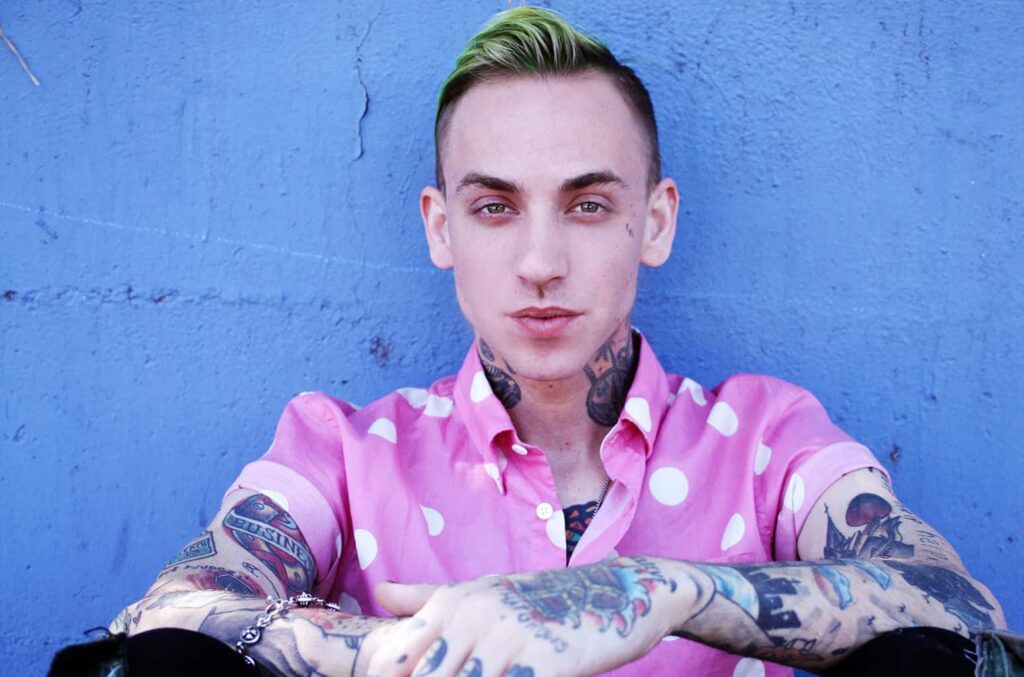Gnash and Blackbear are two names synonymous with the rise of emo rap. Both artists carved their own paths within the genre, exploring themes of heartbreak, self-doubt, and the complexities of young adulthood. While often grouped together, their musical approaches diverge in fascinating ways, reflecting the multifaceted nature of emo rap itself.
Gnash: The Vulnerable Confessionalist

Garrett Nash, the man behind the moniker gnash, emerged in the mid-2010s with a raw, lo-fi aesthetic. Tracks like “I Hate U, I Love U” (featuring Olivia O’Brien) became viral sensations, capturing the turbulent emotions of young love with unflinching honesty. Gnash’s music is characterized by melancholic melodies, often built around acoustic guitar or ukulele, and lyrics that delve into the depths of emotional vulnerability:
- His breakout hit, “I Hate U, I Love U,” perfectly exemplifies this approach. The song’s title encapsulates the push-and-pull of a toxic relationship, while the lyrics detail the constant cycle of fighting and making up;
- Gnash’s delivery is conversational, almost whispering at times, as if sharing a secret with the listener. This vulnerability resonates deeply with fans, creating a sense of intimacy and shared experience.
However, gnash’s music can occasionally veer into melodrama. His lyrics, while relatable, sometimes lack the depth needed to fully explore complex themes. Additionally, the repetitive nature of his production choices, particularly in his early work, can leave listeners wanting more sonic variety.
Blackbear: The Genre-Bending Provocateur

Matthew Tyler Musto, better known as Blackbear, presents a stark contrast to Gnash. While Gnash embraces a more stripped-down, acoustic sound, Blackbear injects elements of pop, hip-hop, and even R&B into his music:
- This genre-bending approach allows him to explore a wider range of emotions, from the swaggering confidence of “Do It Again” to the introspective melancholy of “Hot Girl Bummer.”;
- Blackbear’s production is more polished and elaborate than Gnash’s, often featuring catchy hooks and layered electronic textures. His lyrics are similarly focused on heartbreak and emotional turmoil, but with a more sardonic and self-deprecating edge;
- Tracks like “idfc” showcase this tendency, where Blackbear embraces numbness as a coping mechanism for heartbreak.
This willingness to experiment has propelled Blackbear to mainstream success, scoring him collaborations with artists like Mike Posner and Travis Barker. However, his focus on catchiness can come at the expense of lyrical depth at times. Additionally, some listeners find his more pop-infused sound to be derivative or lacking the raw authenticity of gnash.
A Collaboration of Chameleons
Despite their differences, Gnash and Blackbear have a surprisingly successful collaborative history. Tracks like “My Heart Won’t Stop Breaking” demonstrate how their individual strengths can complement each other. Gnash’s vulnerability provides the song’s emotional core, while Blackbear’s pop sensibilities elevate the production to new heights.
This collaborative spirit extends beyond the studio. Both artists have been vocal about their admiration for each other, and their shared experiences navigating the emotional complexities of young adulthood create a sense of camaraderie that resonates with fans.
The Legacy of Gnash & Blackbear
Gnash and Blackbear’s influence on the music industry is undeniable. They are pioneers of the emo rap genre, paving the way for a wave of artists who explore themes of heartbreak and self-doubt with unapologetic honesty.
Their music resonates with a generation grappling with the pressures of social media, the complexities of modern relationships, and the anxieties of young adulthood. While their approaches differ, both artists offer a soundtrack for the emotional rollercoaster of youth, capturing the rawness of vulnerability in a way that connects with listeners on a deeply personal level.
The Future of Emo Rap: A Branching Path
The influence of Gnash and Blackbear extends beyond just topping charts. They’ve helped legitimize the exploration of vulnerability and emotional turmoil within hip-hop, paving the way for a new generation of artists who are pushing the boundaries of the genre.
Here’s a glimpse into the branching paths emo rap is taking, inspired by the legacies of Gnash and Blackbear:
- The Lo-Fi Revival: Artists like CORPSE and Wicca Phase Springs Eternal are drawing inspiration from gnash’s raw, lo-fi aesthetic, creating music that feels deeply personal and intimate. These artists often utilize cloud rap elements, characterized by hazy production and distorted vocals, further emphasizing the introspective nature of their music;
- The Pop-Punk Fusion: Bands like The Wonder Years and Neck Deep are blurring the lines between emo rap and pop-punk. Their music retains the emotional core of emo rap but injects it with the energy and anthemic qualities of pop-punk. This creates a sound that is relatable and sing-along-worthy, appealing to fans of both genres;
- The Bedroom Producer Revolution: The DIY spirit of Gnash and Blackbear’s early work continues to inspire a wave of bedroom producers. Platforms like SoundCloud and Bandcamp provide a space for these artists to experiment and share their music directly with fans. This fosters a sense of community and allows for a diversity of sounds within the emo rap scene;
- The Genre-Bending Experimenters: Following Blackbear’s lead, artists like Lil Peep and XXXTentacion (both deceased) explored a more genre-bending approach. Their music incorporated elements of rock, electronica, and even industrial music, creating a sound that was both emotionally raw and sonically adventurous. While their tragic deaths left a void in the scene, their influence continues to be felt;
- The Rise of Female Voices: While emo rap has traditionally been dominated by male artists, there’s a growing presence of female voices in the genre. Artists like Princess Nokia and Rico Nasty are challenging traditional gender roles within hip-hop, addressing themes of heartbreak and self-discovery with refreshing honesty and fierceness.
The future of emo rap is fluid and ever-evolving. Gnash and Blackbear may have laid the groundwork, but a new generation of artists is pushing the boundaries, incorporating diverse influences and forging their own identities. This continuous growth ensures that emo rap remains a vibrant and relatable genre for young listeners navigating the complexities of life.
In Conclusion
Gnash and Blackbear are more than just two successful artists; they are cultural catalysts. Their music has provided a voice for a generation grappling with emotional turmoil, and their influence continues to shape the landscape of hip-hop. Also, don’t miss the news about the new BØRNS tour
